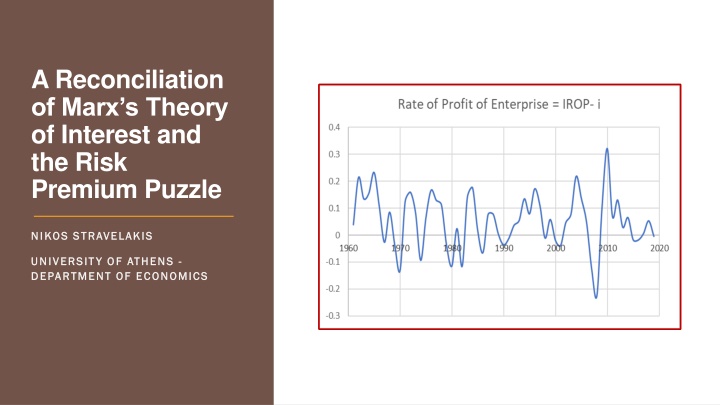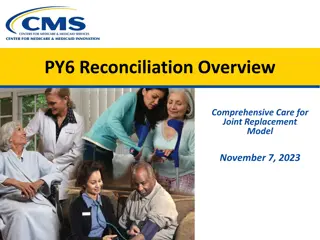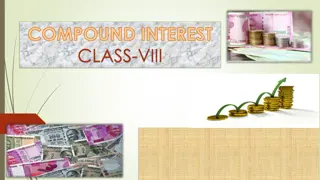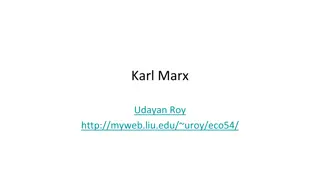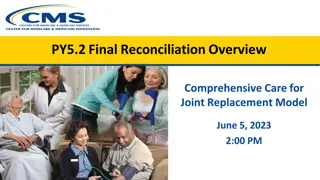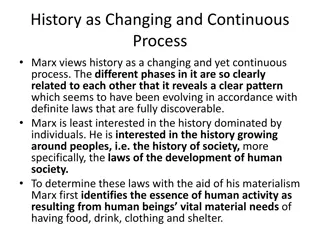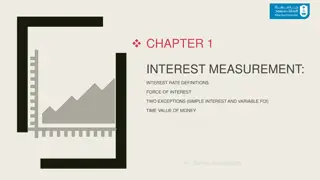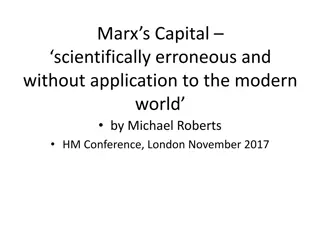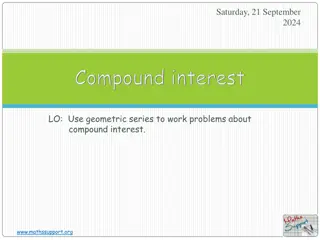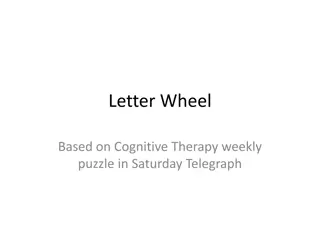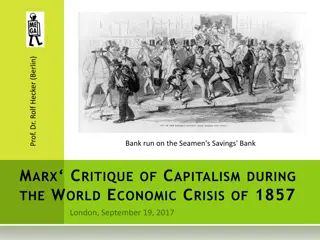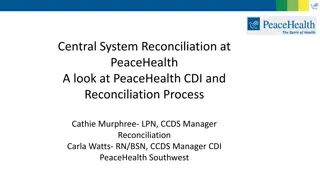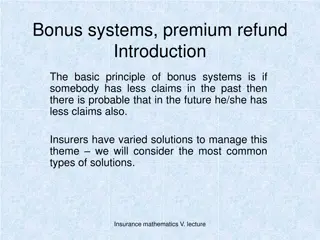Reconciliation of Marx's Theory of Interest and the Risk Premium Puzzle
Equity risk premium puzzle challenges mainstream finance theory, while an alternative theory based on the incremental rate of profit offers a new perspective. The empirical evaluation of the theory sheds light on the dynamics of stock market returns.
Download Presentation

Please find below an Image/Link to download the presentation.
The content on the website is provided AS IS for your information and personal use only. It may not be sold, licensed, or shared on other websites without obtaining consent from the author.If you encounter any issues during the download, it is possible that the publisher has removed the file from their server.
You are allowed to download the files provided on this website for personal or commercial use, subject to the condition that they are used lawfully. All files are the property of their respective owners.
The content on the website is provided AS IS for your information and personal use only. It may not be sold, licensed, or shared on other websites without obtaining consent from the author.
E N D
Presentation Transcript
A Reconciliation of Marx s Theory of Interest and the Risk Premium Puzzle NIKOS STRAVELAKIS NIKOS STRAVELAKIS UNIVERSITY OF ATHENS UNIVERSITY OF ATHENS - - DEPARTMENT OF ECONOMICS DEPARTMENT OF ECONOMICS
The Equity risk Premium Puzzle Mainstream finance theory cannot explain the difference between the equity returns and the rate of interest. The reason is that the basic rate of interest is considered a risk-free rate of return and its difference with the returns of other assets is a risk premium reflecting asset price/ return volatility. However, the risk premium must be compatible with the risk free asset , The reason is that theory implies a constant risk aversion utility function. The latter means that the level and volatility of the risk free asset is reflected on the premium basis the coefficient of risk aversion . Mehra and Prescott (1985) applied this rationale in a simulation of the risk premium . The real return on the risk-free asset in the United States for the period 1889-1978 was 0,8% whereas the average annual real return on equity index was 6,98%, therefore the actual average annual risk premium was 6,08%. The maximum admissible risk premium in the figure is 0,35% well off the actual data. This huge discrepancy has gone down to literature as the equity risk premium puzzle .
An Alternative Theory of Equity Pricing An alternative theory of equity pricing can be established on the idea that stock market returns follow the incremental rate of profit (IROP). In other words, the profit on the most recent investments. Many analytical and empirical studies indicate that it is around this rate that the return between the regulating capitals in the commodity sector takes place. In other words, it regulates the mobility of capital between sectors. The same notion is extended to encompass the tendency of equalization between the corporate and stock market returns i.e. IROP regulates the mobility of capital between the corporate and the financial sector as well. This is close to the assertions of mainstream theory (Elton & Gruber 1976) but in the classical/ Marxian context the IROP is a highly volatile measure and indeed it is. In the classical theory of competition corporations constantly introduce new products and techniques that alter profitability and returns reflecting back on stock prices. This happens through market expectations. But here expectations can alter the fundamentals because the regulating rate of profit (IROP) depends to certain extend on the banking capital and the corporate leverage. This reflects back on prices and up to certain point makes expectations a self fulfilling process. It is the George Soros reflexivity theory that introduces, contrary to rational expectations and the efficient market hypothesis, path dependence and bias in the formation of expectations. The latter can lead to bubbles and exaggerations but if/ when fundamentals deteriorate it leads to the sharp corrections that are witnessed in stock markets.
Empirical Evaluation of the Theory The IROP can be defined as the ratio of the change in profits ( Pr Pr) normalized by investment ( ) IROP= IROP= Pr Pr/I /I. In terms of the theory this means the rate of return on a stock index P/P = IROP can be reformulated as follows: ??+?= (? + ?????) ??. Shaikh (2016) has simulated an equation of this form 1947 until 2009 and I extended the simulation until 2019. The results are shown in the chart next. Moreover, IROP has almost the same average with the average return of the S&P 500 (IROP 7.77%, S&P 8,86%) and similar standard deviation. P/P = IROP. This equation I have applied also a non-parametric technique using the log growth rate of the Earnings per Share (EPS) as the fundamental. The theory is known as transfer entropy and the applied statistic as Mutual Information (MI). The statistic measures the amount of information" obtained about the log growth of the S&P 500 by observing the log growth of the EPS. Here mutual information (MI) is used as a tool for detecting order/ disorder transitions in the stock exchange. This approach is analyzed in Wicks, Chapman, and Dendy (2007). As shown in the chart next it reveals a very interesting pattern that supports reflexivity theory . Real Gross Profit Pr Real Investment I S&P 500 Index Price P Time Earnings Per Share Incremental Rate of Profit IROP= Pr/I t EPS
Extending the Rationale to the Interest Rate Can we extend this equalization assumption to encompass interest rate determination? In other words can we consider that the Interest Bearing Capital enters the equalization process like the Money Dealing Capital? We can, provided that banks are part of the process as capitalist enterprises. The latter means that the rate of interest is not a rate of return but a price that tends to equalize the returns of the regulating corporate and banking capitals with those of commodity capitals. This approach was taken by Panico (1989). In his context exogenous liquidity premia determine both the rate of profit and the rate of interest as outlined in the set of equations next where interest rates determine prices. Shaikh (2016) built on Panico but did not use liquidity premia. He added a banking price equation (including costs and returns) together with the price equations of the corporate sector (as indicated in the equation set appearing next). This way he determines the interest rate from the solution of a Sraffian model. The theory has many interesting properties : a) the difference between the rate of profit and the rate of interest has nothing to do with risk, b) there is no natural interest rate since for every price level corresponds a different rate of interest, c) it offers an explanation of the Gibson Paradox . p a w r Price Vector Input row coomodity sector l wage regulating rate of profit banking liquidity premium abnk input row banks labor input com. Sector labor input bank Sector basic interest rate corporate liquidity premium lbnk io Nevertheless, the solution is static and points to an average gravity centre rate of interest.
Alternative Formulation and Empirical Evaluation of (IROP i) This formulation does not oppose the one in Shaikh (2016) but has different characteristics: a) it places the emphasis on the time series of the difference between the incremental rate of profit (IROP) and the rate of interest (i), b) it does not necessarily imply an average (normal) rate of interest . At the analytical level this means that the IROP is mainly determined in the commodity sector an a highly volatile interest rate tends to make the returns between corporate and interest bearing capital equal. At the empirical level I worked on the idea that a high ratio of net to gross corporate profits implies quick turnover of loaned funds and a fast restoration of the depository base of the banking sector. In this environment banks will expand their asset side without asking for much higher interest rates. The opposite holds for low net profits. On these grounds the interest rate can be written as follows ??= ????? ? ??, ??=???? ??? This can be incorporated in the framework discussed so far. Specifically, abstracting from direct banking costs Shaikh s equation takes the following form ??= ????? ?? ?? ?? ??= ????? ?? ??. Combining the two forms we get ????? ??= ? ??= ????? ?? ?? . In ?? words, the rate of profit of enterprise depends on profitability (IROP) and the ratio of free reserves to loans (?? ?? ). ??
Probabi l i t y Tabl e 1962- 2019 RoPoE Incr. Decr. 58 Incr. Decr. 0.36 0.09 0.45 0.24 0.31 0.55 0.60 0.40 y4 Frequency prob Continued 21 0.36206897 5 14 0.24137931 18 0.31034483 -0.47337 -0.52917 58 0.0862069 H RoPoE H y4 I(RoPoE, y4) H(RoPoE, y4) MI (RoPoE, y4 )2 -0.5189 -0.43973 0.152277402 -0.530671293 0 0 1 0.992267 0.968898 -0.090007981 -0.304832147 -0.523879446 1.359382886 Explanatory Power Corporate net profits are positively related to bank deposits and net to gross profits are positively related to the loan deposit ratio. But more interestingly the Mutual Information statistic (since it is difficult to perform an unbiased estimation of the parameter ) provides information explaining more that 60% of the variations in the difference between the rate of profit and the rate of interest (IROP i). Given that the average IROP is almost equal to the average rate of return of the S&P 500 the equity premium is no puzzle and has nothing to do with risk. 0.156520564 0.218789985 0.601781462 0.606471525 Of course one should not take this trouble just try to explain the equity premium. The important part is to identify the significance of the Rate of Profit of Enterprise in the triggering of major capitalist crises. At first I must stress that the definition of the measure in relation to the IROP instead of the Average Rate of Profit does not contradict the argument in Marx. On the contrary, IROP= Pr/I reflects by definition the stagnation in the mass of profit that result from a falling Average Rate of Profit and signifies capitalist crises. Moreover from the definition of the rate of profit of enterprise a lower IROP (due to stagnant profits) signifies also lower Net Profits, higher interest rates, and a stagnant or even negative Rate of Profit of Enterprise . This is the pattern of the data that appears in the chart next.
Final Remarks Is this the Theory of Interest in Marx? Probabi l i t y Tabl e 1962- 1982 RoPoE Incr. Decr. 21 It is difficult to say whether Marx intended to treat the rate of interest as a rate of return or as a price. At a point (Ch 21 V.III) he says that money in the form of Interest-Bearing Capital turn to a sui a different part he states There is no reason at all why the average conditions of competition, of equilibrium between lender and borrower, should give the lender an interest of 3, 4, 5 per cent . Marxist economists have also argued in favor on both ideas appearing in V.III. Finally, we should not forget what Engels pointed out on section V of V.III we had no finished draft, not even a scheme whose outlines might have been filled out, but only the beginning of an elaboration-often just a disorderly mass of notes, comments and extracts. So, what I have presented is an attempt reconcile Marx s theory of interest with the rest of the theory. Incr. Decr. 0.33 0.05 0.38 0.19 0.43 0.62 0.52 0.48 y4 sui generis generis commodity commodity . . In Frequencyprob both rise RoPoE up y down RoPoE down y up both fall 7 0.333333 1 0.047619 H RoPoE H y4 4 0.190476 -0.53041 -0.48865 0.246747 9 0.428571 -0.42831 -0.50971 21 I(RoPoE, y4) H(RoPoE, y4) MI (RoPoE, y4 )2 -0.528320834 0 0 1 0.958712 0.998364 -0.09189 -0.209157973 -0.523882466 1.261361272 Explanatory Power 0.231375 0.386236 0.695714283 0.725676082 Nevertheless, and let this be the closing point, distribution of profit in profit of capital and profit of enterprise does not depend exclusively on gross and net corporate profitability. As the 19thcentury Scottish economist George Ramsay (cited on many occasions by Marx) puts it: the unproductive borrowers, government and others, by their competition tend to keep up the rate of interest . This is true especially at times of deregulation of the financial markets. To elaborate on this point, I broke down the calculation of MI in two periods (1962- 1982) and the period of neoliberalism (1982-2019). The results shown in the two probability tables are indicative. Pr obabi l i t y Tabl e 1983- 2019 RoPoE Incr. Decr. 38 Incr. Decr. 0.39 0.11 0.50 0.26 0.24 0.50 0.66 0.34 y4 Frequencyprob 15 0.394737 4 0.105263 H RoPoE H y4 10 0.263158 9 0.236842 38 both rise RoPoE up y down RoPoE down y up both fall I(RoPoE, y4) H(RoPoE, y4) MI (RoPoE, y4 )2 -0.5 -0.39742 0.103829 -0.5 -0.5294 1 0.926819 -0.07373 -0.529356678 0 0 1 -0.341887107 -0.49215849 1.363402274 Explanatory Power 0.111194 0.141293 0.56341679 0.56341679
